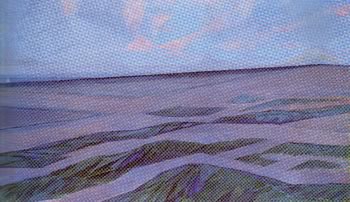Sadly for Mondrian, in this time of success, he suffered a tragic event that sent him off course, perhaps this was for the better as it caused him to change his style. The reason was his mother's death while she was still young, and her death must have been very unexpected. He dealt with this loss by unleashing a sudden impulse of new ideas which lost much of his public backing that he had fought for so long to obtain. This can be seen in his paintings Dune IV, and Dune Landscape. Mondrian continued in this new manner, culminating in The Red Mill (1911) that “…confronts the viewer with a towering wall of colour of cold intensity…” (Deicher: Mondrian pg. 28). With this painting he seems to have turned his back on the public and their support.
During the 1910's, Mondrian's style varied drastically as he was introduced to new concepts, and new ideas. This was when he started to experiment with strong colours and the use of form, as well as beginning a reduction in detail, however this was not observed until later on in this period.
At the end of this year, 1911, Mondrian moved to Paris and left Amsterdam. It was here that he met a man that would forever change his direction with art: that man was Pablo Picasso. A man that Mondrian recognised as the greatest painter of his age.
 Dune Landscape (1911).
Dune Landscape (1911).